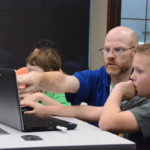What is Scratch Programming?
Scratch is a programming language for kids that makes it easy to create. It uses a visual-based interface that is like a LEGO building. With this software kids make their own interactive stories, animations, games, music, and art. In addition, they can even share their creations on the web and collaborate with others. Developed by the Lifelong Kindergarten Group at the MIT Media Lab, Scratch was created with the goal of developing a program that was more “tinkerable”, more meaningful, and more social than other programming languages.
Classroom Antics and the developers of Scratch at MIT are inspired by the way children play and build with LEGO bricks. Given a box full of them, children immediately start building and snapping together a few bricks. Their emerging LEGO structure then gives them new ideas. As they play and build, plans and goals evolve organically, along with the structures and stories. Programming with Scratch has this same feel.
How is Scratch Like LEGO Building?
The Scratch programming platform is based on a collection of graphical “programming blocks” that children snap together to create programs. As with LEGO bricks, connectors on the blocks suggest how they should be put together. Children can start by simply tinkering with the bricks of code. By snapping code together in different sequences and combinations to see what happens the learning begins. A process that is similar to LEGO building.
Scratch programming is not the first collaborative project between the Lifelong Kindergarten research group and the LEGO Company. In the past, they have developed LEGO Mindstorms and LEGO WeDo robotics kits. These kits have been a great starting point for engineering and technology education for students. Based on the enjoyment we have observed from this partnership during our summer day camps at Classroom Antics, we hope it will not be the last.







